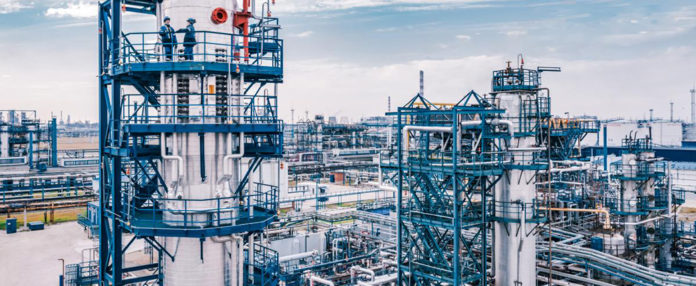
Gazprom Neft’s new 220,000 metric tons per year Group II and III base oil production in Omsk is scheduled to start streaming by the end of September, with first commercial loadings to take place in October, industry insiders told Lube Report.
The final preparations and making of trial batches in now taking place, the company’s lube arm Gazpromneft-Lubricants said in an Aug. 29 news release. The $450 million plant was scheduled to start streaming in December 2022, but completion was pushed back to later this year.
The company said the upgrade of the Omsk base oil plant aims for “complete replacement of imported base oils and supply of the Russian market with lubricants manufactured with domestic components.”
The lubricant complex in Omsk also features a 110,000 t/y finished products blending plant.
“This will be Russia’s largest complete-cycle production of synthetic oils applied in automotive equipment and in the equipment used in industrial production,” Gazpromneft-Lubricants said.
When construction began in January 2021, Gazpromneft said it was using technology licensed from ExxonMobil. ExxonMobil, which was among the energy companies that exited Russia after the country invaded Ukraine in February 2022, said in December that it cancelled the order to provide wax isomerization technology and is not supporting Gazprom Neft with any catalyst and technical service.
Gazpromneft’s press release stated that the upgraded plant uses hydro-treating and wax isodeparaffinization to bolster the base oils’ low-temperature properties. The company did not reply by deadline to a request for details about the technology.
Part of the European Union sanctions against Russia include a ban on export to the country of specific goods and technology needed for oil refining. The bloc also imposed an embargo on import of Russian crude oil and refined petroleum products, with some limited exceptions.
“Gazprom Neft can replicate the same technology used in its Group III base oil plant in Yaroslavl, so I don’t think they will have problems to maintain the plant, not in a short term,” Oleg Tsvetkov, chief specialist at Topchiev Institute of Petrochemical Synthesis of the Russian Academy of Science, told Lube Report last week.
The 100,000 t/y Group III base oil plant in Yaroslavl, a 50-50 joint venture between Rosneft and Gazprom Neft, was put into operation in 2017 as an upgrade of the refinery’s existing Group I capacity. Before the Russian invasion of Ukraine, it sold Group III base oils with no approvals.
Regardless of its proximity to the Chinese and other Asian markets, the new unit in Omsk, a big city in Western Siberia, is pitched mostly for domestic use, according to an industry insider.
“Gazprom Neft built this unit mostly for domestic usage as a way to develop premium lubricants production in Russia,” Denis Varaksin, base oil trader at the Berlin-based DYM Resources, said.
He noted that some products from this plant may end up in friendly nearby markets, such as Turkey or in South America, and that the Russian base oils are not going to Asia.
“There is no demand for the Russian base oils in Asia,” Varaksin said. “China has not been buying Russian base oils for several years now, related to the COVID-19 restriction from 2020, which are still not lifted. Asia is oversupplied with Group II and Group III base oils from its local suppliers.”
COVID-19 pandemic restrictions halted the rail transportation of Russian base oil going to China via Mongolia.
In his opinion, Turkey and Latin America can be the only export prospects for the base oil plant in Omsk.
“Shipments to Turkey can be executed through the Black Sea port of Novorossiysk, while the shipments to South America can go through the port in St. Petersburg,” he explained, adding that, however, this would be a difficult task because “export routes and [the number of potential buyers] are very limited due to the sanctions.”
Besides Gazprom Neft, Russia has two other existing domestic Group III base oil producers: Taneco, a subsidiary of Tatneft, which operates a 90,000 t/y Group II and 100,000 t/y Group III plant in Nizhnekamsk and Lukoil’s plant in Volgograd, which has capacity to make 220,000 t/y of Group II and 30,000 t/y of Group III base oils.